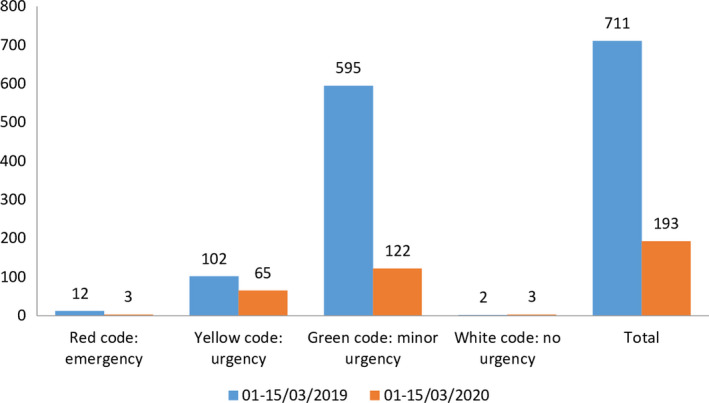Coronavirus disease 2019 (COVID‐19) is an infectious disease caused by a novel coronavirus, SARS‐CoV‐2.
After finding the first cases in Italy, the government declared a state of emergency. In The Lancet, Stefano Spina et al 1 reported the strategy of the emergency medical system (EMS) of the metropolitan area of Milan to contrast the recent COVID‐19 outbreak in Italy. The EMS instituted a team that manages the patients and their flow to local hospitals. This response is critical, given the public health problem and the need to avoid the emergency department overcrowding.
Before the COVID‐19 outbreak, the problem of overcrowding in the emergency room was raised in several countries of the world. 2 , 3 , 4 It was associated with increased mortality, 5 delayed care 6 and reduced physician job satisfaction. 7
During the last years, the paediatric emergency department (PED) of 'Policlinico Universitario A. Gemelli IRCCS' in Rome assists an increasing number of patients, around 14 500 per year. Serious and urgent cases are treated, but also those related to social unease or unfounded fears of patients and parents.
The causes of overflow are multiple. On the one hand, as the number of patients increases, that of the staff of the National Health Service (NHS) decreases, caused by the blocking of turnover. From 2009 to 2017, the number of people employed in the NHS decreased by 46 500.
On the other hand, for many patients, the emergency department is the place to do several tests together, free of charge and without waiting lists.
Another element is that the primary care centres are unable to solve people's health problems: they are devoid of diagnostic tools and do not guarantee home care.
Crowding causes long waits, patient anger and stress for doctors, with a subsequent drop in the quality of care.
During the recent COVID‐19 outbreak in Italy, some recommendations were issued by the Ministry of Health, including that of avoiding access to the emergency room in case of fever or cough. 8 It is important, in fact, to prevent the possible infection to other patients and doctors and the possible creation of new epidemic outbreaks.
Indeed, we observed that during the first 2 weeks of March 2020, compared to the previous year, there was a significant drop in the number of visits to our PED: from 711 to 193 admissions, corresponding to a reduction of 72.9% (Figure 1).
Figure 1.

Admissions to our PED: comparison between March 01‐15, 2019, and March 01‐15, 2020
The number of patients with important diseases that can be treated has decreased 9 ; however, especially the number of children with non‐serious pathology has diminished. The main cause of this phenomenon is attributable to the fact that patients and parents are afraid of being infected by SARS‐CoV‐2.
Crowded areas and no beds: this was the situation of our emergency room at this time of year. Instead, during these days the situation is diametrically opposite: short waits and free beds.
In conclusion, at least half of emergency room patients have problems that could be solved elsewhere. When looking for the reasons why the emergency rooms of Italian hospitals are full, you can criticise the organisation of the system, the lack of resources and the limited help provided by some categories of doctors, but it cannot be ignored the role of citizens. In an age of consumerism, including health care, there is a growing demand for rapid responses from those who are not seriously ill. In fact, in order to avoid waiting lists of weeks or months for non‐urgent examinations and specialist consultations, patients access the emergency room and receive a rapid diagnosis.
The recent epidemic has given us with an important lesson: it eliminated the inequalities and made us suffer and work together, creating a sense of pride and national belonging. In addition to these fundamental feelings, however, we must not forget another important lesson: the best use of the emergency department.
CONFLICT OF INTERESTS
None.
REFERENCES
- 1. Spina S, Marrazzo F, Migliari M, et al. The response of Milan's Emergency Medical System to the COVID‐19 outbreak in Italy. Lancet. 2020;395(10227):e49‐e50. [DOI] [PMC free article] [PubMed] [Google Scholar]
- 2. Andrulis DP, Kellermann A, Hintz EA, Hackman BB, Weslowski VB. Emergency departments and crowding in United States teaching hospitals. Ann Emerg Med. 1991;20:980‐986. [DOI] [PubMed] [Google Scholar]
- 3. Shih FY, Ma MH, Chen SC, Wang HP, Fang CC, Shyu RS. ED overcrowding in Taiwan: facts and strategies. Am J Emerg Med. 1999;17:198‐202. [DOI] [PubMed] [Google Scholar]
- 4. Derlet RW, Richards JR. Overcrowding in the nation's emergency department: complex causes and disturbing effects. Ann Emerg Med. 2000;35:63‐68. [DOI] [PubMed] [Google Scholar]
- 5. Richardson DB. Increase in patient mortality at 10 days associated with emergency department overcrowding. Med J Aust. 2006;184:213‐216. [DOI] [PubMed] [Google Scholar]
- 6. Pines JM, Hollander JE, Localio AR, et al. The association between emergency department crowding and hospital performance on antibiotic timing for pneumonia and percutaneous intervention for myocardial infarction. Acad Emerg Med. 2006;13:873‐878. [DOI] [PubMed] [Google Scholar]
- 7. Rondeau KV, Francescutti LH. Emergency department overcrowding: the impact of resource scarcity on physician job satisfaction. J Healthc Manag. 2005;50:327‐340. [PubMed] [Google Scholar]
- 8. http://www.salute.gov.it/portale/nuovocoronavirus/dettaglioFaqNuovoCoronavirus.jsp?lingua=italiano&id=228#11, 20/03/2020
- 9. Isba R, Edge R, Jenner R, Broughton E, Francis N, Butler J. Where have all the children gone? Decreases in paediatric emergency department attendances at the start of the COVID‐19 pandemic of 2020. Arch Dis Child. 2020. 10.1136/archdischild-2020-319385. [Epub ahead of print]. [DOI] [PubMed] [Google Scholar]


